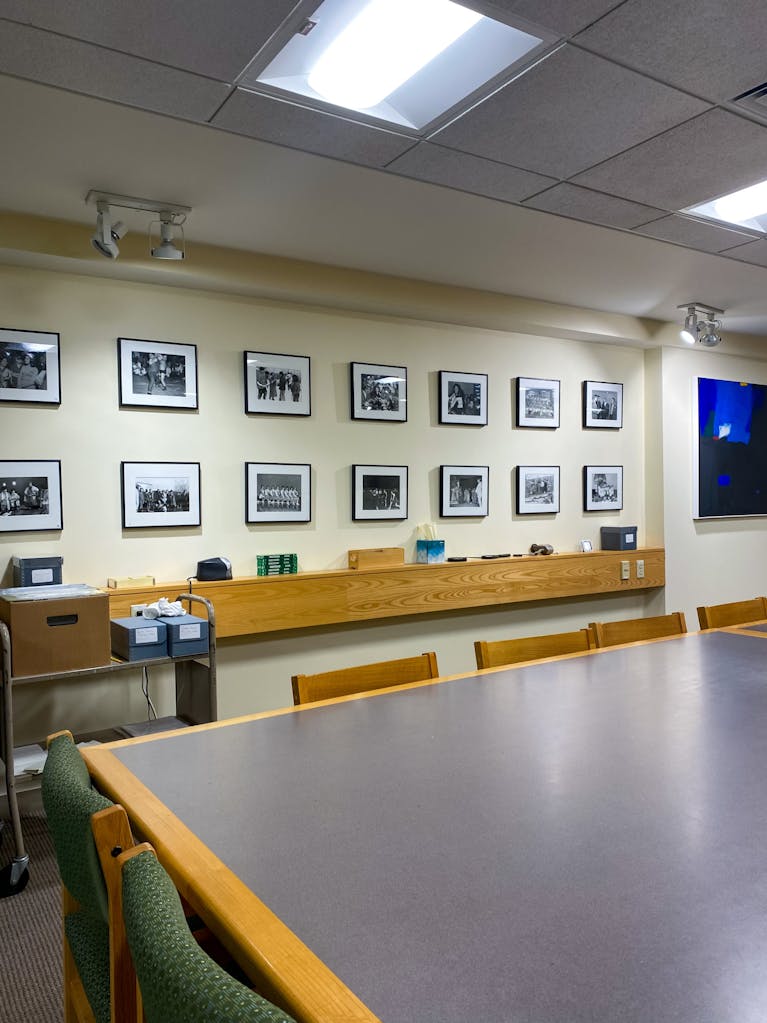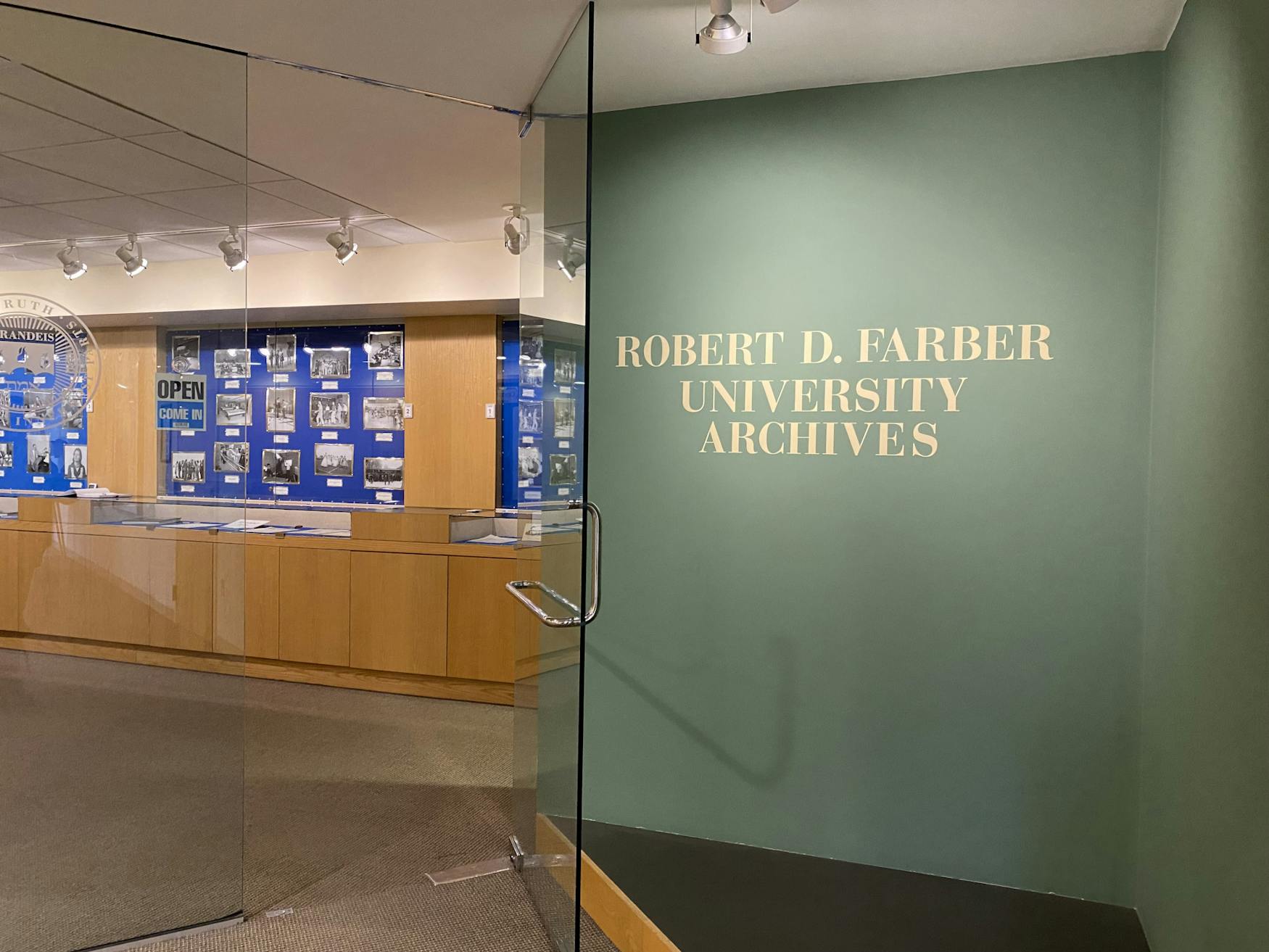Housing gems in the library: Visiting the Robert D. Farber University Archives and Special Collections department
On April 14, The Justice spoke with Chloe Gerson, Reference and Instruction Archivist who works at the Robert D. Farber University Archives & Special Collections.
You may have walked past it when hunting down a quiet study spot on the second floor of the Goldfarb Library: the Robert D. Farber University Archives & Special Collections. Right past the reference desk, down the stairs to the second floor of Goldfarb, it lies behind the glass door: the past of Brandeis summarized in glass displays, featuring a picture of the first graduating class to previous school merchandise from the 1980’s.
Funding was provided by Leonard L. Farber for the department in 1997. The department was inaugurated in the year 1998 and named after Farber’s son, Robert. The University had been collecting archival items for a while beforehand, but now had a centered location in which to store them.
On April 14, The Justice spoke with Chloe Gerson, who works with the University Archives and special collections as the Reference and Instruction Archivist. She handles requests for the University archives and special collections from all over the world and leads instruction sessions. Gerson has led class sessions for various subjects, such as legal studies, anthropology, foreign language classes, sociology, University Writing Seminars and more.
Gerson shared that people will usually say that the most rare thing the university special collections has is Shakespeare’s first folio. She also stated, “We got things in all types of languages from all over the world, in tons of different subjects. We have some very interesting, interesting things.” Starting with a papyrus document from 120 A.D., documents from the 1600s, 1700s and 1800s, the university archives and special collections continue to collect, now having to use an offsite storage location. “Space is always an issue, and we have to get creative about it.”
When asked about her favori

te part of the job, Gerson replied, “You know — I love the hunt. I love hunting for things, I love working with people. It’s nice to connect people with things they are looking for, things people didn’t know they were looking for.”
Since the archives are not browsable, it is usually through requested collections that anyone will find interesting documents and artifacts. Students may use the “Finding Aids Database” on the Brandeis Library website to look beforehand to see if anything that they need or are interested in is available. Another way of looking at the archives in an effective manner would be to email Gerson beforehand regarding the topic you are interested in so that those collections are ready when you arrive.
Gerson loves opening up the “world of archives” to students, “showing them that it is accessible, that is for them and not just people with four PhD’s.”
Reflecting on a memorable experience during an instruction session, Gerson recalled a student had been looking at a Planned Parenthood pamphlet from the 50-60s time period and shared that his grandmother was in the chapter. It was a connection to an archived document he had no previous idea about.
Gerson shared that interactions like these that make her position so rewarding. “Everytime that somebody leaves a class and they say, ‘Wow, that was really exciting, thanks,’ or when people stay after a class and then they are like, ‘How do you get into this field?’ it’s opening up a world that people didn’t know existed or know that they could exist in.”

When discussing who can come to the archives, Gerson stated “All you need to be is interested. We’re open access, anybody can come here.” She also shared that people come from all over the world, including places like the Netherlands and Switzerland, for all sorts of reasons, from projects to books that are planning to be published.
She also explained that people come from so far away because the archives hold a very unique collection with artifacts that cannot always be digitized. This can be a result of lack of consent from the donor or sensitive conditions that make it unable to be scanned, such as a book being bound too tightly.
“We had someone come all the way from California to look at our Joan Crawford awards collection and had brought his nephew with him, and his nephew was taking pictures of everything, pictures of him holding up the awards. And so we brought out this correspondence that we have of her and between Abram Sachar, the first [Brandeis] president and he was like, pumped. It was so nice to see him so excited about being able to touch something that was Joan Crawford’s,” Gerson recalled.
When asked what she wished more people knew about the University Archives and Special Collections, Gerson shared she wished “For more people to know that they are totally allowed to come here. We love for people to know that we exist, feel how paper was made in the 1700s, just because they want to.” While located inside of the library, the archives are a world of their own that is waiting to be explored.
— Editor’s Note: Editor Anna Martin ‘26 works for the archives.



Please note All comments are eligible for publication in The Justice.